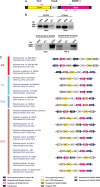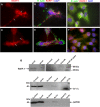TolC-dependent secretion of an ankyrin repeat-containing protein of Rickettsia typhi
- PMID: 22773786
- PMCID: PMC3430354
- DOI: 10.1128/JB.00793-12
TolC-dependent secretion of an ankyrin repeat-containing protein of Rickettsia typhi
Abstract
Rickettsia typhi, the causative agent of murine (endemic) typhus, is an obligate intracellular pathogen with a life cycle involving both vertebrate and invertebrate hosts. In this study, we characterized a gene (RT0218) encoding a C-terminal ankyrin repeat domain-containing protein, named Rickettsia ankyrin repeat protein 1 (RARP-1), and identified it as a secreted effector protein of R. typhi. RT0218 showed differential transcript abundance at various phases of R. typhi intracellular growth. RARP-1 was secreted by R. typhi into the host cytoplasm during in vitro infection of mammalian cells. Transcriptional analysis revealed that RT0218 was cotranscribed with adjacent genes RT0217 (hypothetical protein) and RT0216 (TolC) as a single polycistronic mRNA. Given one of its functions as a facilitator of extracellular protein secretion in some Gram-negative bacterial pathogens, we tested the possible role of TolC in the secretion of RARP-1. Using Escherichia coli C600 and an isogenic tolC insertion mutant as surrogate hosts, our data demonstrate that RARP-1 is secreted in a TolC-dependent manner. Deletion of either the N-terminal signal peptide or the C-terminal ankyrin repeats abolished RARP-1 secretion by wild-type E. coli. Importantly, expression of R. typhi tolC in the E. coli tolC mutant restored the secretion of RARP-1, suggesting that TolC has a role in RARP-1 translocation across the outer membrane. This work implies that the TolC component of the putative type 1 secretion system of R. typhi is involved in the secretion process of RARP-1.
Figures







Similar articles
-
The Rickettsial Ankyrin Repeat Protein 2 Is a Type IV Secreted Effector That Associates with the Endoplasmic Reticulum.mBio. 2018 Jun 26;9(3):e00975-18. doi: 10.1128/mBio.00975-18. mBio. 2018. PMID: 29946049 Free PMC article.
-
Secretome of obligate intracellular Rickettsia.FEMS Microbiol Rev. 2015 Jan;39(1):47-80. doi: 10.1111/1574-6976.12084. Epub 2014 Dec 4. FEMS Microbiol Rev. 2015. PMID: 25168200 Free PMC article. Review.
-
Characterization of Sec-translocon-dependent extracytoplasmic proteins of Rickettsia typhi.J Bacteriol. 2008 Sep;190(18):6234-42. doi: 10.1128/JB.00794-08. Epub 2008 Jul 18. J Bacteriol. 2008. PMID: 18641131 Free PMC article.
-
Functional analysis of secA homologues from rickettsiae.Microbiology (Reading). 2005 Feb;151(Pt 2):589-596. doi: 10.1099/mic.0.27556-0. Microbiology (Reading). 2005. PMID: 15699207
-
Progress in rickettsial genome analysis from pioneering of Rickettsia prowazekii to the recent Rickettsia typhi.Ann N Y Acad Sci. 2005 Dec;1063:13-25. doi: 10.1196/annals.1355.003. Ann N Y Acad Sci. 2005. PMID: 16481486 Review.
Cited by
-
Architecture and roles of periplasmic adaptor proteins in tripartite efflux assemblies.Front Microbiol. 2015 May 28;6:513. doi: 10.3389/fmicb.2015.00513. eCollection 2015. Front Microbiol. 2015. PMID: 26074901 Free PMC article. Review.
-
Genomes of Candidatus Wolbachia bourtzisii wDacA and Candidatus Wolbachia pipientis wDacB from the Cochineal Insect Dactylopius coccus (Hemiptera: Dactylopiidae).G3 (Bethesda). 2016 Oct 13;6(10):3343-3349. doi: 10.1534/g3.116.031237. G3 (Bethesda). 2016. PMID: 27543297 Free PMC article.
-
The Rickettsial Ankyrin Repeat Protein 2 Is a Type IV Secreted Effector That Associates with the Endoplasmic Reticulum.mBio. 2018 Jun 26;9(3):e00975-18. doi: 10.1128/mBio.00975-18. mBio. 2018. PMID: 29946049 Free PMC article.
-
Secretome of obligate intracellular Rickettsia.FEMS Microbiol Rev. 2015 Jan;39(1):47-80. doi: 10.1111/1574-6976.12084. Epub 2014 Dec 4. FEMS Microbiol Rev. 2015. PMID: 25168200 Free PMC article. Review.
-
Genomic diversification in strains of Rickettsia felis Isolated from different arthropods.Genome Biol Evol. 2014 Dec 4;7(1):35-56. doi: 10.1093/gbe/evu262. Genome Biol Evol. 2014. PMID: 25477419 Free PMC article.
References
Publication types
MeSH terms
Substances
Grants and funding
LinkOut - more resources
Full Text Sources
Molecular Biology Databases
Research Materials

